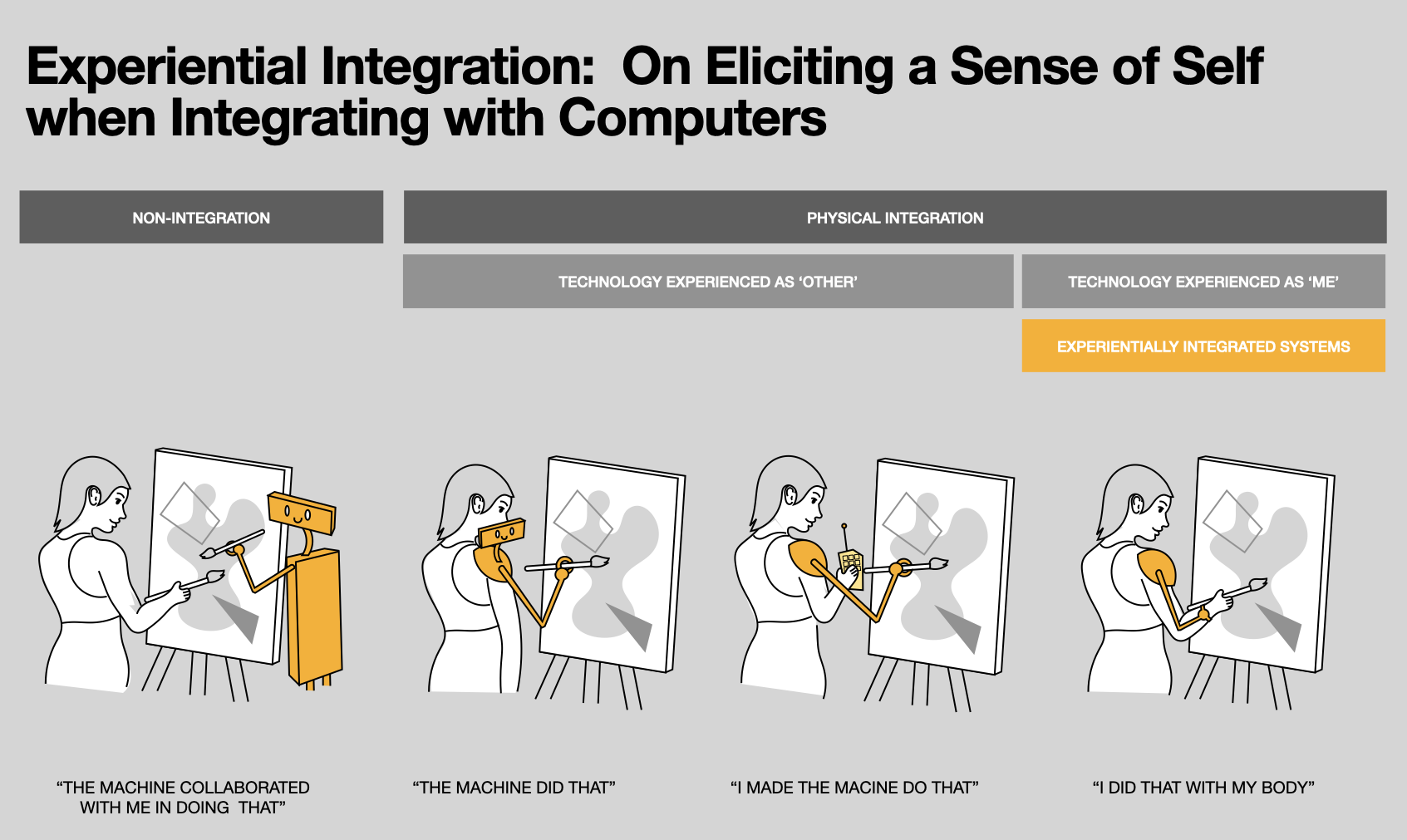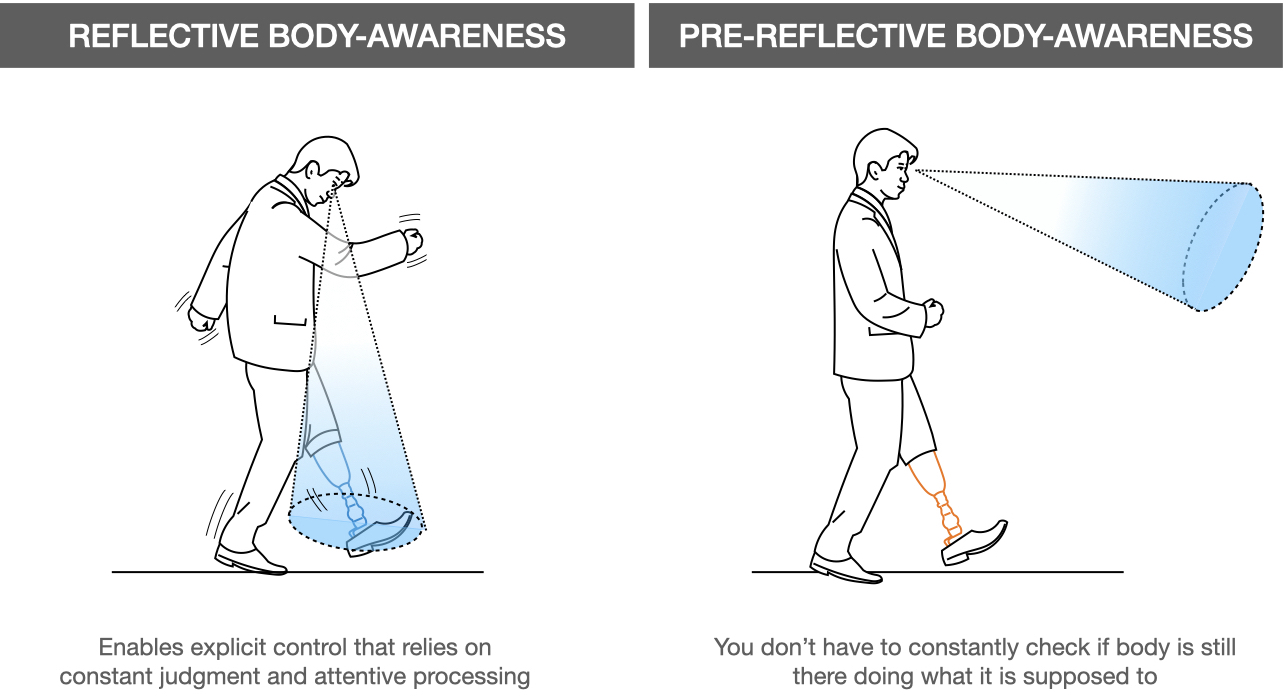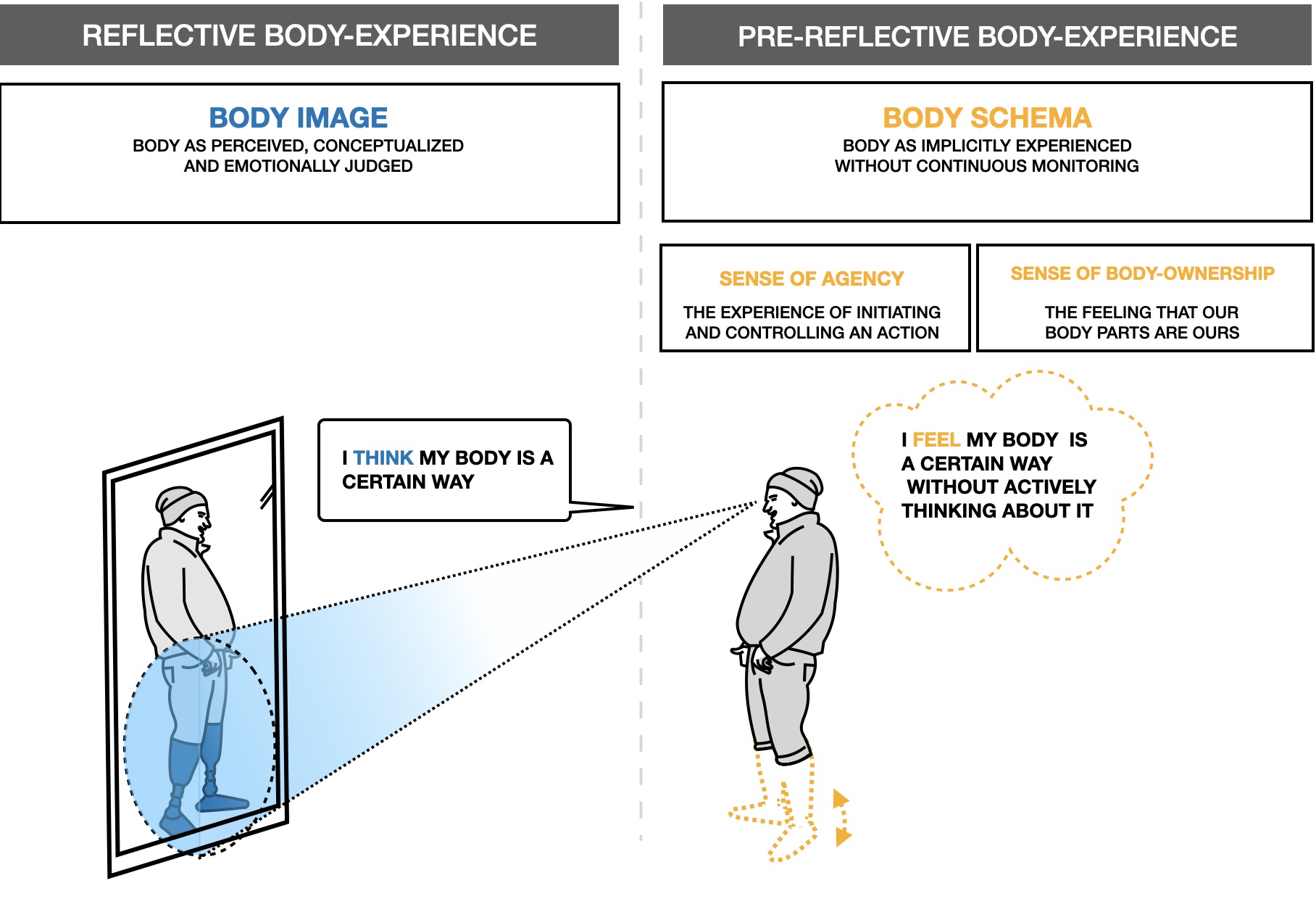
The emerging field of Human-Computer Integration investigates how humans and technology can be united as "one human-technology assemblage" with the purpose of enhancing human physical and cognitive capabilities. While many systems have successfully demonstrated functional integration of humans and technology, little attention has been paid to the experiential sense of self in such integration, in particular, how an integration might feel as part of the user. In this paper, we discuss the idea of experiential integration, align that with evidence from cognitive science, and discuss its implications for Human-Computer Integration design and evaluation. We propose a scientifically informed approach to Human-Computer Integration, which emphasizes pre-reflective senses of body-ownership, the feeling that our body parts are ours, and agency, the experience of initiating and controlling an action, as requirements for inducing the experience of an external artifact being part of the self. Our aim is to shed light on the importance of experiential integration and provide researchers with a scientifically driven foundation for future designs and investigations.
![]()
In regards to experiencing our body, modern phenomenological and cognitive sciences research emphasize two main kinds of awareness which modulate our bodily experience, through (i) reflective body-awareness, and (ii) pre-reflective body-awareness. Here, reflective body-awareness is characterized as an attentive experience of ourselves as a thing where we take ourselves as the object of experience and it is this kind of awareness which constitutes and alters our body-image or self-perception. Pre-reflective body-awareness, on the other hand, is the tacit experience of our body when it isn't the focus of our attention, e.g. the implicit tactile sensations on under my feet when engaged in a conversation, the sense that my body does as I intend it to, and that it is mine and not anyone else's. When we are engaged with the world, our perceptions, actions, movements, etc. are all enabled by the physical and sensorimotor structures of the body. But while performing these actions, we do not need to be reflectively aware of our limb-positions, movements etc. Instead, the body acts 'in the background', or pre-reflectively, without needing our direct and continuous monitoring or attention. This allow us to focus our attention towards other things without having to constantly check in e.g. our limbs’ positions.
This distinction can be deployed to understand how an amputee use or experience their prosthetic. While reflective awareness of the prosthetic limb enables initiation of finer and more precise motor movement, it also limits conscious attention to just that body part. In contrast, pre-reflective awareness of the limb enables less detailed movement, while freeing up cognitive resources allowing us to focus our awareness away from our body and onto the task at hand.
![]()
When evaluating integration, most researchers have focused on changes in users' reflective self-perception or judgement of an integration as part of their body, e.g. their “relational self”, “body-image”, “self-image”, etc., while overlooking the pre-reflective aspects of body-experience such as the pre-reflective sense of body-ownership - the sense that I am the one who is undergoing an experience with my body (for instance, that it is my body that is moving) and the preflective sense of agency - the sense that I am the one who is causing or generating an action (for instance, that I am the one moving my body) which are felt without requiring conscious observation and reflection.
Phantom limb patients are an example of this, as they are reflectively aware that they are missing a limb (it isn’t part of their self-concept or body image) while they still ‘pre-reflectively’ experience a limb as part of their body. A system designed only to satisfy users' reflective self-perception may be subject to such invasive risks, therefore, researchers should address pre-reflective aspects in their designs and evaluations.
![]()
Driven by the discussions on the categorization of reflective and pre-reflective body awareness, the sufficient conditions of experiential integration and evaluation of body-integrated technology, we propose a description of the space of experiential integration and a design framework to drive its implementation. We categorized design parameters into two groups: functional - i.e. parameters pertaining to the applied function of a system, and experiential - i.e. parameters critical in eliciting a full sense of self over a given technology integrated with the body. We divided the evaluation of those systems into three subsections. Functional evaluation describes conventional performance evaluation metrics that investigate whether the system was effective in achieving a target task. Reflective evaluation includes prevalent approaches utilized in cognitive science and recent HCI works, where reflective ways of evaluating self-perception - body image, judgments of agency, or judgments of ownership - are utilized in forms of self-reports or questionnaires. Finally, experiential evaluation suggests an extension of the existing scope of evaluation towards not just reflective but pre-reflective aspects of using the system. In our article, we outline specific key design parameters that HCI researchers can utilize for experiential integration e.g. incorporating afferent and efferent information into their design. Through a substantive review of literature on Human-Computer Integration concerned with some form of experiential integration, we identified a lacking understanding and utilization of these parameters.
![]()

Feeling that a computer is part of you can have functional implications on a user, such as protective behaviors, availability expectations, and help avoiding negative psychological effects such as depersonalization. Credit: Fluid Interfaces
In regards to experiencing our body, modern phenomenological and cognitive sciences research emphasize two main kinds of awareness which modulate our bodily experience, through (i) reflective body-awareness, and (ii) pre-reflective body-awareness. Here, reflective body-awareness is characterized as an attentive experience of ourselves as a thing where we take ourselves as the object of experience and it is this kind of awareness which constitutes and alters our body-image or self-perception. Pre-reflective body-awareness, on the other hand, is the tacit experience of our body when it isn't the focus of our attention, e.g. the implicit tactile sensations on under my feet when engaged in a conversation, the sense that my body does as I intend it to, and that it is mine and not anyone else's. When we are engaged with the world, our perceptions, actions, movements, etc. are all enabled by the physical and sensorimotor structures of the body. But while performing these actions, we do not need to be reflectively aware of our limb-positions, movements etc. Instead, the body acts 'in the background', or pre-reflectively, without needing our direct and continuous monitoring or attention. This allow us to focus our attention towards other things without having to constantly check in e.g. our limbs’ positions.
This distinction can be deployed to understand how an amputee use or experience their prosthetic. While reflective awareness of the prosthetic limb enables initiation of finer and more precise motor movement, it also limits conscious attention to just that body part. In contrast, pre-reflective awareness of the limb enables less detailed movement, while freeing up cognitive resources allowing us to focus our awareness away from our body and onto the task at hand.

Reflectively and pre-reflective body-awareness modulates body-experience in various ways. Reflective body-awareness enables higher degrees of control and perceptual detail through continuous monitoring, while pre-reflective body-awareness enables semi-autonomous control and low-level body-experience (i.e. a feeling of it being there doing what it is supposed to without demanding your full attention)
When evaluating integration, most researchers have focused on changes in users' reflective self-perception or judgement of an integration as part of their body, e.g. their “relational self”, “body-image”, “self-image”, etc., while overlooking the pre-reflective aspects of body-experience such as the pre-reflective sense of body-ownership - the sense that I am the one who is undergoing an experience with my body (for instance, that it is my body that is moving) and the preflective sense of agency - the sense that I am the one who is causing or generating an action (for instance, that I am the one moving my body) which are felt without requiring conscious observation and reflection.
Phantom limb patients are an example of this, as they are reflectively aware that they are missing a limb (it isn’t part of their self-concept or body image) while they still ‘pre-reflectively’ experience a limb as part of their body. A system designed only to satisfy users' reflective self-perception may be subject to such invasive risks, therefore, researchers should address pre-reflective aspects in their designs and evaluations.

Reflective body-experiences such as the body-image denote how the userthinksabout orjudgestheir body (in this case aprosthetic user), while pre-reflective body-experiences such as body schematic processes and senses of agency and body-ownership over our limbs denote the more tacit feelings of our body when focus is elsewhere (in this case the experience of the prosthetic as if they are real legs.
Driven by the discussions on the categorization of reflective and pre-reflective body awareness, the sufficient conditions of experiential integration and evaluation of body-integrated technology, we propose a description of the space of experiential integration and a design framework to drive its implementation. We categorized design parameters into two groups: functional - i.e. parameters pertaining to the applied function of a system, and experiential - i.e. parameters critical in eliciting a full sense of self over a given technology integrated with the body. We divided the evaluation of those systems into three subsections. Functional evaluation describes conventional performance evaluation metrics that investigate whether the system was effective in achieving a target task. Reflective evaluation includes prevalent approaches utilized in cognitive science and recent HCI works, where reflective ways of evaluating self-perception - body image, judgments of agency, or judgments of ownership - are utilized in forms of self-reports or questionnaires. Finally, experiential evaluation suggests an extension of the existing scope of evaluation towards not just reflective but pre-reflective aspects of using the system. In our article, we outline specific key design parameters that HCI researchers can utilize for experiential integration e.g. incorporating afferent and efferent information into their design. Through a substantive review of literature on Human-Computer Integration concerned with some form of experiential integration, we identified a lacking understanding and utilization of these parameters.

An Overview over the Literature Concerned with Experiential Integration. For each individual article, the parameters introducedin this article and discussed in section 6.1.1 (Experiential Design Parameters and Evaluation of Pre-reflective Experience) are highlightedin different shades of yellow according to their degree of being satisfied
TIME: June 2020 - Now
AUTHORS: Valdemar M. Danry, Pat Pataranutaporn, Sang W. Leigh, Pattie Maes
KEYWORDS: Human-Machine Integration, Experiential Integration, Phenomenology, Cognitive Science, Sense of Ownership, Sense of Agency.
SKILL: Phenomenology, Cognitive Science, Body Illusions, HCI Literature Review
PUBLICATION: Danry, V., Pataranutaporn, P., Maes, P., Leigh, S. (2021, Under Review). Experiential Integration: On Eliciting a Sense of Self when Integrating with Computers (Under Review). In Proceedings of the 2021 CHI Conference on Human Factors in Computing Systems.
WORKSHOP:
Danry, V., Pataranutaporn, P., Horowitz, AH., Strohmeier, P., Andres, J., Patibanda, R., Li, Z., Semertzidis, N., Nakamura, T., Nishida, J., Lopes, P., León, F., StevensonWon, A., Svanæs, D., Mueller, F., Maes, P., Leigh, S. (2021, Under Review). Do Cyborgs dream of Electric Limbs? Experiential Factors in Human-Computer Integration Design and Evaluation. In Proceedings of the 2021 CHI Conference Workshops. http://cyborgdreams.media.mit.edu/.
AUTHORS: Valdemar M. Danry, Pat Pataranutaporn, Sang W. Leigh, Pattie Maes
KEYWORDS: Human-Machine Integration, Experiential Integration, Phenomenology, Cognitive Science, Sense of Ownership, Sense of Agency.
SKILL: Phenomenology, Cognitive Science, Body Illusions, HCI Literature Review
PUBLICATION: Danry, V., Pataranutaporn, P., Maes, P., Leigh, S. (2021, Under Review). Experiential Integration: On Eliciting a Sense of Self when Integrating with Computers (Under Review). In Proceedings of the 2021 CHI Conference on Human Factors in Computing Systems.
WORKSHOP:
Danry, V., Pataranutaporn, P., Horowitz, AH., Strohmeier, P., Andres, J., Patibanda, R., Li, Z., Semertzidis, N., Nakamura, T., Nishida, J., Lopes, P., León, F., StevensonWon, A., Svanæs, D., Mueller, F., Maes, P., Leigh, S. (2021, Under Review). Do Cyborgs dream of Electric Limbs? Experiential Factors in Human-Computer Integration Design and Evaluation. In Proceedings of the 2021 CHI Conference Workshops. http://cyborgdreams.media.mit.edu/.
